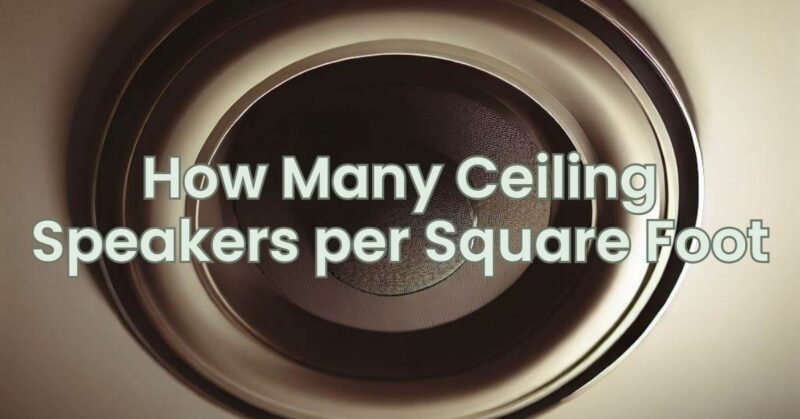Ceiling speakers are a popular choice for distributed audio systems, providing immersive sound without taking up valuable floor or wall space. When planning a ceiling speaker installation, it’s important to consider the number of speakers needed to achieve optimal sound coverage and quality. In this article, we will discuss the factors to consider when determining the ideal number of ceiling speakers per square foot, including room size, speaker characteristics, and desired audio experience. By understanding these considerations, you can make informed decisions for your ceiling speaker layout.
Room Size and Shape
The size and shape of the room play a significant role in determining the number of ceiling speakers required. Consider the following factors:
- Square Footage: Start by calculating the total square footage of the room. This will serve as a baseline for determining the number of speakers needed. As a general guideline, you can allocate one speaker for every 100 to 200 square feet of space. However, this can vary depending on the desired audio coverage and sound level requirements.
- Room Configuration: The shape and layout of the room can influence the speaker placement and coverage. Irregularly shaped rooms or those with obstacles like columns or partitions may require additional speakers to ensure uniform sound distribution.
Speaker Characteristics and Coverage Angle
Understanding the characteristics of your ceiling speakers is crucial in determining the number needed. Consider the following aspects:
- Speaker Power and Sensitivity: The power and sensitivity rating of the speakers will impact their coverage capabilities. Higher-powered speakers with greater sensitivity can cover larger areas, reducing the number of speakers needed. Conversely, lower-powered speakers may require more units to achieve the desired audio coverage.
- Coverage Angle: Each ceiling speaker has a specific coverage angle, indicating the width of the sound projection. Consider the coverage angle of the speakers and ensure they overlap adequately to avoid gaps or dead zones in audio coverage. Adjust the number of speakers accordingly to ensure even sound distribution.
Audio Experience and Desired Sound Level
The desired audio experience and sound level preferences are subjective and will influence the number of speakers chosen. Consider the following factors:
- Sound Intensity: If you require higher sound levels for immersive experiences or background music in noisy environments, additional speakers may be necessary. This will ensure sufficient sound dispersion and volume throughout the room.
- Zoning and Sound Control: If you plan to create separate audio zones within the room or require independent volume control in different areas, you may need more speakers to accommodate the desired zoning and control capabilities.
Room Acoustics and Speaker Placement
The acoustic properties of the room and the placement of the ceiling speakers will affect the overall sound quality and coverage. Consider the following:
- Room Reflections: Take into account the room’s acoustics, including the presence of hard surfaces that can cause reflections or echo. In rooms with poor acoustics, additional speakers may be required to compensate for sound degradation or loss due to reflections.
- Speaker Spacing: Ensure proper spacing between the ceiling speakers to achieve an even sound distribution. As a general guideline, consider spacing the speakers approximately 6 to 10 feet apart, depending on the room size and acoustic characteristics. Adjust the number of speakers accordingly to achieve the desired spacing.
Here are some of the most popular types of ceiling speakers
- In-ceiling speakers: In-ceiling speakers are installed in the ceiling. They are a good option for rooms where you do not want to see the speakers.
- On-ceiling speakers: On-ceiling speakers are mounted on the ceiling. They are a good option for rooms where you want to see the speakers.
- Outdoor ceiling speakers: Outdoor ceiling speakers are designed to be used in outdoor applications. They are a good option for patios, decks, and other outdoor areas.
Conclusion
Determining the ideal number of ceiling speakers per square foot involves considering various factors such as room size, speaker characteristics, desired audio experience, and room acoustics. By assessing these factors and understanding your specific requirements, you can determine the appropriate number of speakers for optimal sound coverage and quality. Remember, it’s always recommended to consult with audio professionals or system integrators who can provide customized recommendations based on your specific needs and the characteristics of your space. With careful planning and consideration, you can create a well-balanced and immersive audio environment using ceiling speakers.


